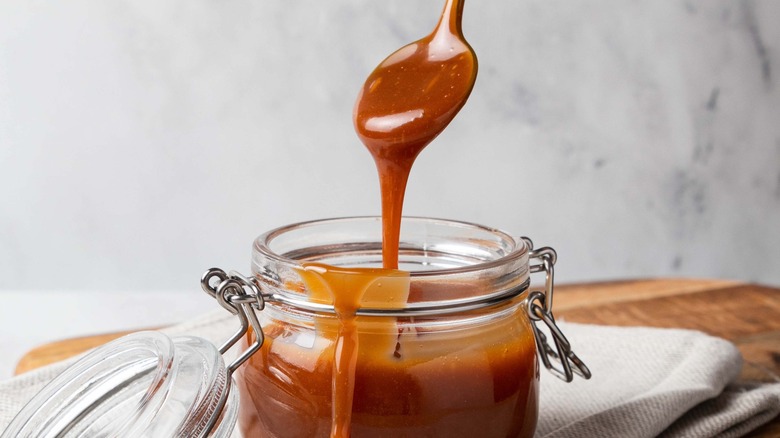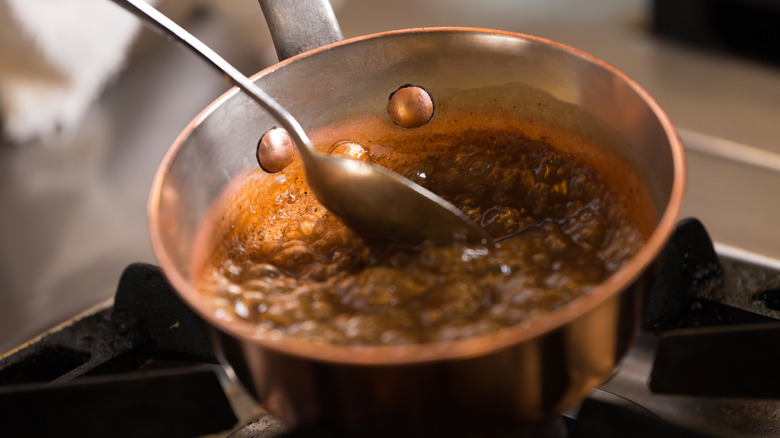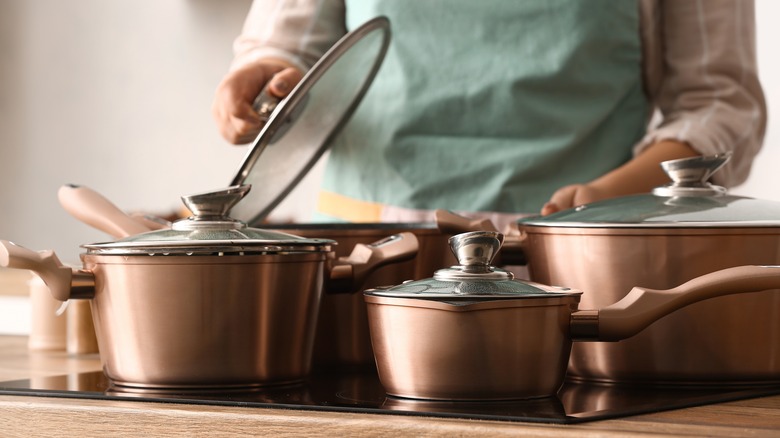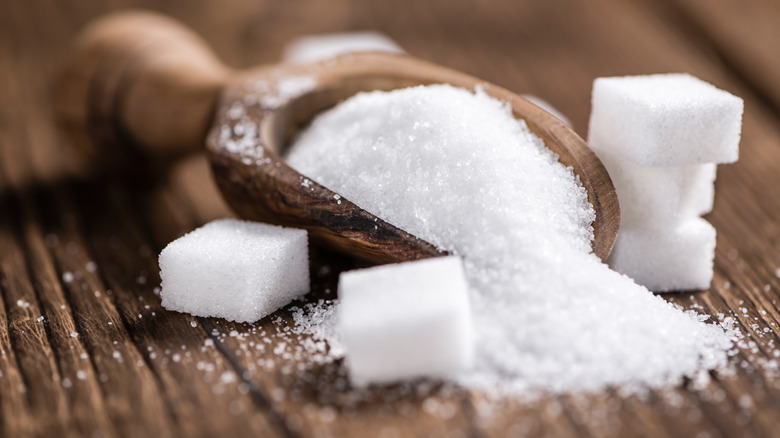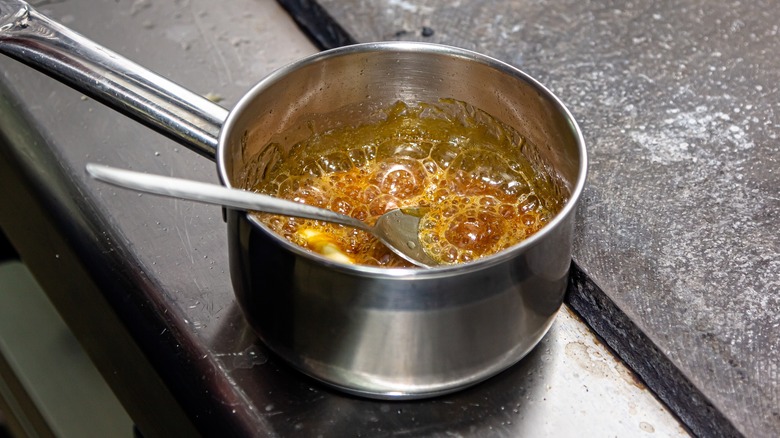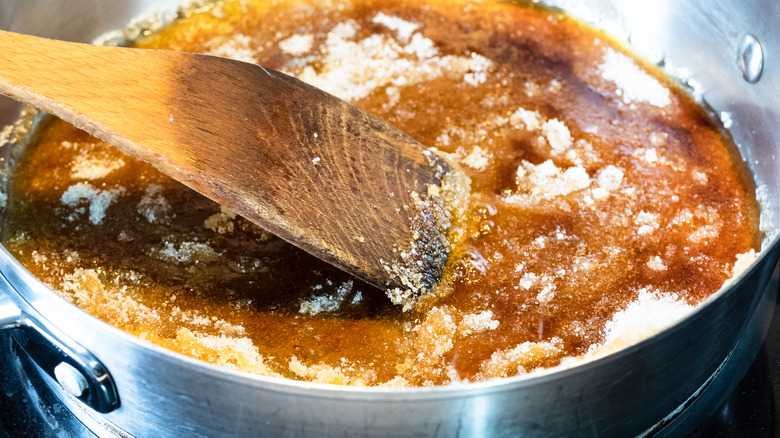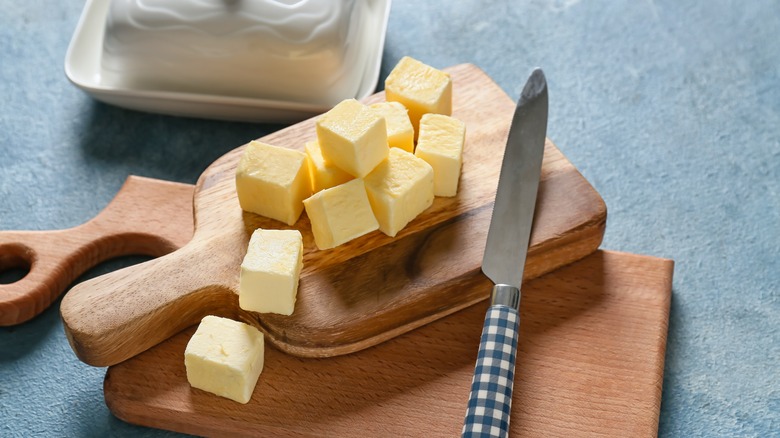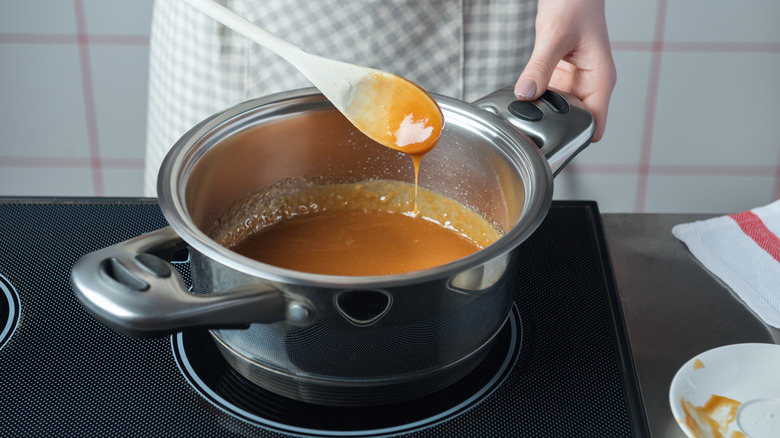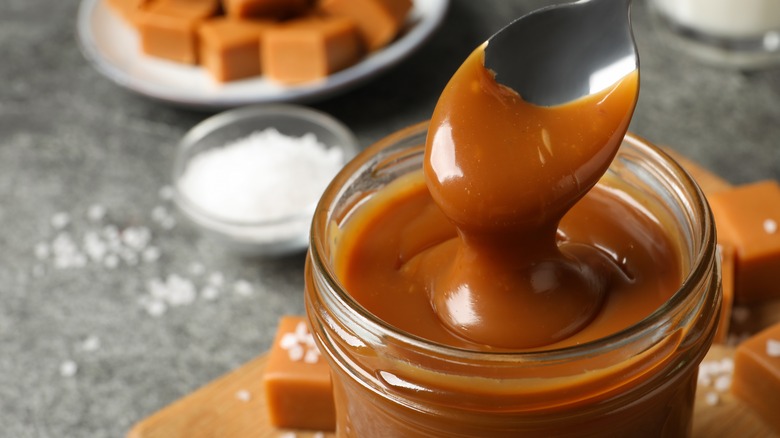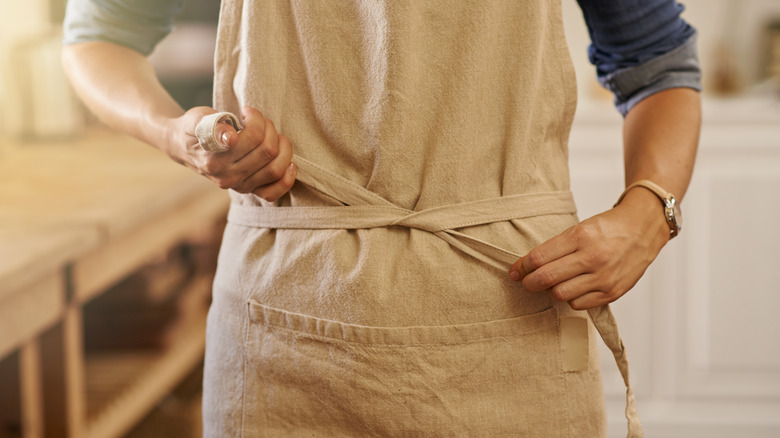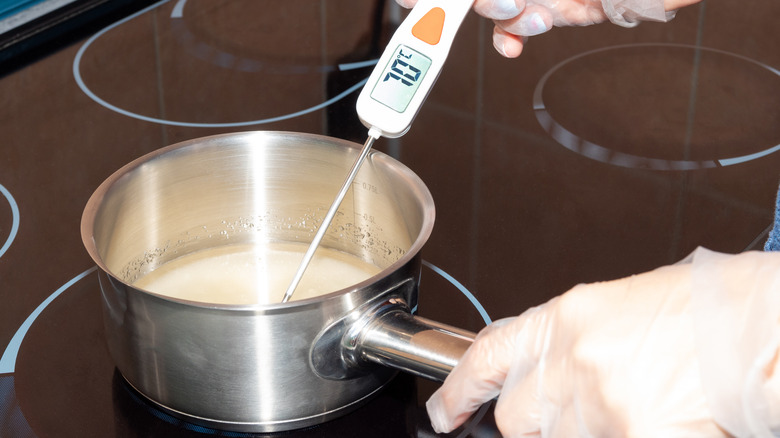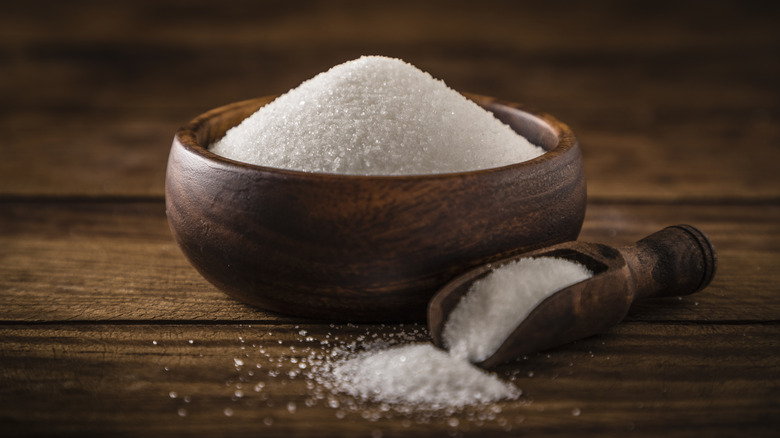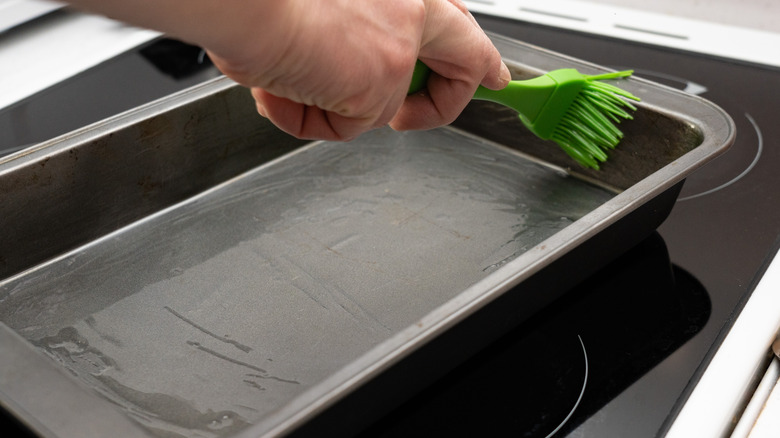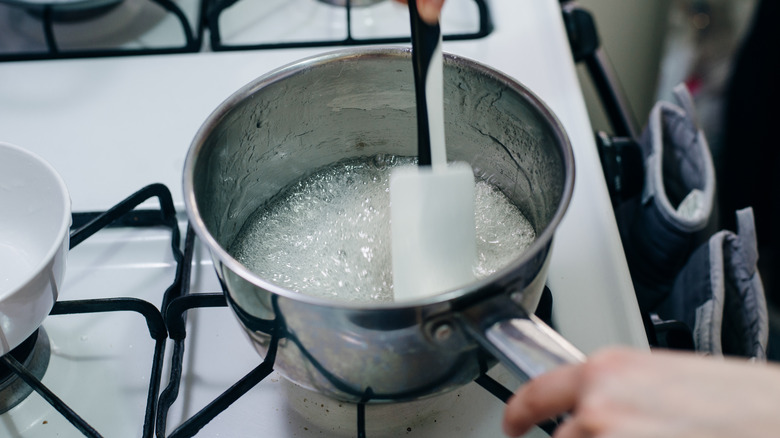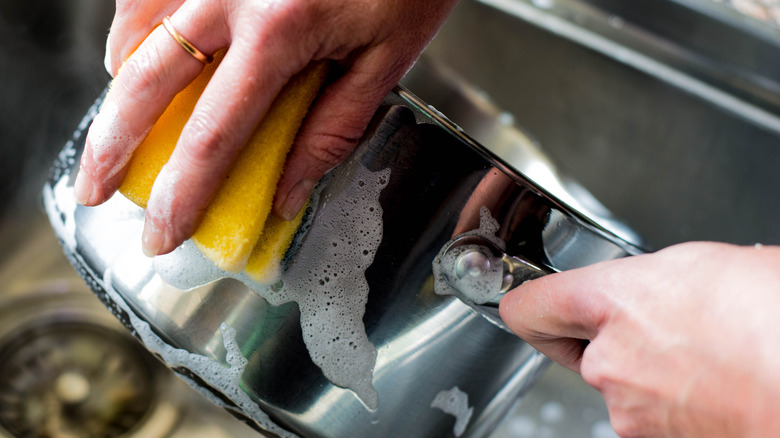14 Common Mistakes Everyone Makes With Homemade Caramel
Think of candy, and you'll likely think of caramel. This confectionery item has been central to sweet recipes around the globe for centuries and allegedly has been around since the 11th century, with its popularity in the West occurring towards the end of the 19th century. Caramel, in its most basic form, is made by melting sugar, but the degree to which the sugar is melted and the ingredients that are then added to it determines the type of caramel you end up with. By adding cream or milk, for example, you can make a gooey caramel sauce, whereas using a different-colored sugar can leave you with butterscotch or toffee.
Whatever you're using to make caramel, though, the process involves a lot of heat and a lot of risk. Sugar can become incredibly hot and very sticky when it's cooked, making it highly dangerous to handle. To add to this, it's also a substance that burns exceptionally quickly and has to reach a very specific temperature to make caramel effectively. All of these factors make cooking caramel at home pretty daunting, which is partly why we leave it to confectioners. Luckily, though, the key to cooking candy-store-level caramel is to avoid the most common mistakes that people make — and we've put them all here.
1. Forgetting the difference between wet and dry caramel
One of the main errors that people make with caramel is assuming that making it is a one-size-fits-all process. But in fact, there are two main methods for making caramel, and both of them will produce different results. Caramel can be divided into "dry" and "wet" caramel, which essentially refers to whether you're adding liquid during the melting process for your sugar. With dry caramel, you simply heat sugar in a pan with nothing else added, waiting for it to melt and caramelize. Wet caramel, on the other hand, mixes the sugar with a liquid, usually water.
Crucially, starting with a dry caramel doesn't necessarily mean you'll end up with a brittle, dry end result — dry caramel processes can still be used to make things like caramel sauce. Their difference lies in the ease with which they're cooked and in their ultimate flavors. Wet caramel can give you a stronger-flavored result, as the water means that the sugar takes longer to brown, intensifying the caramel taste. Wet caramel can also be easier to prepare, as the water stops the sugar from burning so quickly. On the other hand, wet caramel can also be more likely to crystallize, which can ruin it. The difference between the two is that you should always specify whether the caramel you're aiming for is made via a dry or wet method so you don't end up with the wrong product.
2. Starting with the wrong pot
Anyone who's ever made caramel will know how tricky and how hazardous it can be. To make caramel properly, you need consistent heat throughout your cooking vessel to ensure that the sugar is melting at the right rate. You also need to be able to avoid any dangerous spits from the hot sugar and minimize the risk of the mixture overspilling.
And this is why starting with the wrong pot will kill your love of the sweet treat. A shallow pot that heats irregularly is one of the worst pieces of equipment possible for caramel. Instead, you should aim for a pot made from an efficient heat-conducting material, like copper or stainless steel. Both of these options distribute heat effectively, ensuring that no sugar is left uncaramelized and other areas aren't burning — and copper, in particular, is pretty good at cooling, stopping your caramel from continuing to cook when you remove it from the heat.
As well as this, you should make sure that your pot has high sides and a heavy bottom to minimize the risk of spillage. While some people get nervous about using nonstick pans with caramel, fearing that the coating will chip away and incorporate with the sauce, high-quality nonstick pans are generally safe. You should only worry if your nonstick pan is particularly old and the surface is showing signs of deterioration.
3. Picking the wrong sugar
With its deep-brown, luxurious color, it can be tempting to assume that to make caramel, you need a special type of sugar. But in fact, going for a darker-colored sugar, and even just a regular brown sugar, might be a big mistake if you're going for a classic result. While it might seem illogical, regular caramel starts with classic white granulated sugar. As it melts down and starts to heat up, the sugar molecules cook and — you guessed it — caramelize, which is what creates its rich brown color, with a longer cooking time equaling a darker result.
Using brown sugar may produce an instantly brown result when you melt it, but you shouldn't mistake that for complexity. As a matter of fact, it may ruin your caramel. Brown sugar has a darker color because it's mixed with molasses (not, as you might expect, because it's partially caramelized). Molasses introduces an entirely different flavor into the caramel mixture, and crucially, it's an acidic ingredient with a pH as low as 5. This has the risk of introducing instant bitterness into your caramel and making the finished sauce unpleasant.
4. Trying to melt your sugar too quickly
Melting sugar can be a fun experience, but it can also be fraught with challenges. And it can be difficult to know exactly which temperature to choose when doing it. This can lead to people cranking up the heat in an effort to melt the sugar as quickly as possible. However, if you're making dry caramel, using a high heat can cause some of the sugar particles to melt faster than others, with parts of the mixture then caramelizing before other parts of it have time to liquefy. The result is an uneven, bitty caramel, which has an inconsistent taste. If your heat is way too high, you can also scorch the sugar, which will produce a burnt, bitter flavor.
The way to get around this is to stay calm and go slowly. Caramel, and especially dry caramel, should never be rushed. The aim is to heat the sugar up gently and consistently, using a medium-low heat. Keep the sugar moving in the pan constantly with a spatula to make sure that the heat is distributed evenly and no parts are exposed to the hot bottom of the pan for too long. Pretty soon, you'll see it start to soften and melt.
5. Stirring your wet caramel
As making wet caramel involves combining granulated sugar with water, it's natural to assume that stirring it will help. But stirring it too much, especially once it's started to heat up, can be a serious mistake. As wet caramel cooks and heats up, it turns into a syrup. But as this syrup bubbles and reduces, the sugar molecules in the solution can end up fusing back together, a process called recrystallization.
It might seem logical that stirring will prevent this from happening. But by mixing the sugar particles with the water more effectively, the opposite will occur: The sugar crystals will seek each other out and bond together, pushed by your spatula. Instead of this occurring, you should try to avoid stirring it as much as possible. If you need to mix it together or you notice that crystallization is occurring, you can give the pan a gentle swirl — but ideally, you'll leave the syrup mixture to cook without any interference.
If crystallization is a repeated issue for you, try covering your pot to keep the steam and moisture in the mixture and discourage the sugar from clumping together. It's also vital to make sure you have as clean a pot as possible, as any residue that gets into the mixture can encourage the sugars to crystallize.
6. Forgetting to prepare your other ingredients
Making caramel may require patience, but there are moments where you'll need to act very quickly. Caramel can turn from nutty and perfectly brown to burnt in the blink of an eye, and stepping away from the pot to prepare anything you need to add to it can prevent you from spotting it and turning the temperature down in time. As well as this, you'll want to make sure that you're adding your additional ingredients at exactly the right moment and temperature for the optimum result.
But forgetting to prepare your other ingredients can ruin everything. If you haven't sliced your butter or measured out your cream beforehand, you run the risk of your caramel being ruined while you leave it unattended to perform these tasks. Prevent this by preparing your "mise en place," the French term that refers to having all of your ingredients ready to go before you turn the heat on. Cube your butter and measure out your cream, salt, and any other additions. Separate everything into separate containers so you can easily pick them up and toss them in. By prepping a mise en place and having it within easy reach, you can ensure that you're not distracted by any kitchen jobs and can concentrate on nailing the caramel.
7. Overthickening your caramel
The art of getting your caramel to a perfect consistency is a tricky one, and an overly thick sauce is something that way too many people are familiar with. Caramel gets thicker as it simmers, but leaving it for too long can cause it to reduce way too much, leaving you with a sauce that's just not pourable. Additionally, caramel will continue to thicken as it cools, so it's pretty easy for it to become overly viscous, even if you think it's just right when you take it off the heat.
As such, you should aim to take your caramel off the heat just before you think it's finished and allow it to finish thickening up as it drops in temperature. If it's too thick after cooling, adding a small amount of heavy cream to the mixture can make it thinner. Remember, too, that if you've taken your caramel off the heat too soon and it's overly thin, it's pretty easy to make it thicker. Simply pour your caramel back into the pot, add a few tablespoons of water, and heat it back up to a simmer, allowing it to reduce further. Just remember that doing this will cause the caramel to get darker and may affect its taste.
8. Forgetting to be patient
With caramel, it's important not to rush. The process of making it requires you not only to melt the sugar down into a liquid but to then allow that liquid to cook and brown to your desired level. All of this takes time and attentiveness and, crucially, requires a consistently low heat to produce the best results. By trying to crank up the heat or by taking your caramel off the stove too early, you'll end up with a poor batch.
The process of making caramel, from pouring your sugar into the pan to cooking it to just the right consistency, can take around 20-25 minutes. During that time, you need to attend to your pot constantly, making sure that the mixture is not bubbling over or crystallizing. If you're making a very dark caramel, you may need slightly longer.
Importantly, you also need to factor in the time it takes for your caramel to cool, which can take several hours. Forgetting to be patient with the taste of your caramel and trying it before it's fully cooled down can be a risky game and may lead to you burning your mouth.
9. Ignoring safety precautions
It's always important to be careful in the kitchen, but it's never quite as crucial as when you're working with sugar. When the sugar has melted down to syrup, it's able to go far beyond the boiling point of water, meaning that the mixture bubbling in your pot is molten-hot, and any contact with skin is extremely hazardous. Importantly, hot caramel is also thick and sticky, increasing the risk it poses and making it more difficult to cool down immediately. Caramel coming into contact with skin can produce second or third-degree burns, requiring immediate medical intervention (per the Journal of the Korean Burn Society).
Therefore, taking adequate precautions is vital. Try to cover bare skin as much as possible during caramel preparation, and wear an apron to avoid any spillages on your clothes. Make sure that you're using a high-sided pot to cook in to avoid the mixture erupting all over your stove. As many caramel recipes require milk or cream to be poured into the sugar, ensure that you're standing well back when you do this to avoid being splattered as the two solutions react to each other. This will also prevent you from getting caught by any steam that's produced. Finally, if you do get sugar on your skin, you should immediately submerge the affected area in cold water.
10. Forgetting a candy thermometer
Whether you're a first-time caramel maker or a sweet sauce pro, you should be employing a candy thermometer. Making sauces and candy out of caramel is arguably the most scientific of all the cooking processes, and the result you end up with is ultimately determined by temperature, which then influences the concentration of sugar in your final product. For a syrup, your sugar solution should reach a temperature between 230-234 degrees Fahrenheit. But going even just a few degrees higher than that will result in fudge. To produce pure caramel, which concentrates the sugar to 100%, you'll need to get your mixture to somewhere between 320-350 degrees Fahrenheit.
Now, if you've been making caramel your whole life, you may be able to accurately guess when your sugar has reached those temperatures — but candy thermometers take the hassle out of doing so. Try to find a thermometer with a long pen attachment so you can test the temperature without getting too close to the sugar. Finding a candy thermometer that gives accurate and speedy reads is crucial, as you may need to pull your sugar off the heat at a pretty precise moment. Some more advanced models, like the ChefAlarm thermometer, allow you to set an alarm for when the mixture reaches a specific temperature.
11. Getting the incorrect ratio of liquid to sugar
When making wet caramel, you'll naturally need the mixture to be, well, wet. But exactly how wet you make it will influence your final sauce. Adding too much liquid can leave you with a sauce that's too runny or which is dull and flavorless. Too little liquid, on the other hand, may make your caramel unpourable or too sugary.
The secret lies in getting the right ratio of liquid to sugar. As a baseline, you should aim for roughly two parts sugar to one part liquid. Importantly, there is a little flexibility in this, and some recipes can call for slightly less sugar and more water. It's useful to remember that the more water you add, the longer your caramel will likely take to reach a thicker consistency and deeper color, as you'll need the water to cook off sufficiently. On the other hand, using more water can control the cooking process slightly more.
Additionally, keep in mind that using different liquids will give you an entirely different result for your caramel. Opting for heavy cream instead of water, for example, will leave you with a caramel that's thicker and more luxurious, thanks to the higher fat content.
12. Pouring it into the wrong vessel
Depending on the recipe you're following and the type of caramel you're making, you may need to pour it out to allow it to cool — and here's where things get tricky. Caramel is, after all, made of sugar, and sugar can get very sticky when it starts to cool. If you pour it into a pan or a vessel that isn't greased or which is prone to sticking, you may find that half of your caramel sauce gets stuck to the sides.
Instead, you should always work with a greased pan when cooling caramel, especially caramel candy. For the best results, use a cooking spray. Cooking sprays are preferable as they have better coverage, getting into all of the corners of the pan more efficiently. Make sure that you don't use too much cooking spray or too much of any other fat you're using — it will make your caramel too greasy.
You can also use a nonstick baking sheet to cool caramel or pour it onto a sheet pan lined with parchment paper. If you're making a pourable caramel, make sure that it's cooled sufficiently before decanting it into your pouring vessel, especially if it's made of glass or ceramic. The temperature difference may cause the vessel to shatter.
13. Burning your caramel
One of the joys of caramel is its deep, nutty flavor and golden-brown appearance — but it's all too easy to take things too far. Caramel can burn fast, and when it does, it develops a bitter, unpleasant taste. This usually happens due to two main reasons: either leaving your caramel on the stove for too long (often by becoming distracted and stepping away from the pot) or by using a heat that's too high.
The key is to be attentive to your caramel, removing it as soon as it hits the right temperature. Alternatively, you'll know when your caramel is done when it starts to smoke slightly. Crucially, though, caramel will continue to cook once it's off the stove, especially if you have a pot that retains heat easily. To halt this, a quick and easy solution is to prepare an ice bath before you start cooking and then plunge your pot into it as soon as it comes off the heat. The ice bath will immediately bring the temperature down, stopping your caramel from darkening too much. Just be careful when doing this that no water makes its way into the mixture, as it can dilute it.
14. Washing your pan incorrectly
The clean-up job after caramel can seem pretty daunting, especially if things have gone a little awry. If your pan has bubbled over, or you've heated up your caramel too much, you can be left with a crystallized mass of hard, burnt sugar to deal with. But taking a scourer to your pot or trying to chip away at the sugar are some of the biggest mistakes you can make. Both of these things can cause damage to your cookware, and they're especially harmful to nonstick pans and their coating.
Luckily, all you need to clean a caramel-covered pan is time, heat, and plenty of soap. "Fill the sink with hot sudsy water, and immerse the pot in it and let it soak and cool a bit," recommends Good Housekeeping Research Institute Cleaning Lab director Carolyn Forte, per Good Housekeeping. "Wearing rubber gloves, I'd try to remove as much of the caramel as I could as the water softens it." If you need to, you should decant your water and replace it with a fresh, hot batch, repeating until all of the sugar has softened and begun to dissolve. Then, once the sugar has all gone, simply scrub your pot as you normally would, dry, and stash away until the next time you make caramel.
